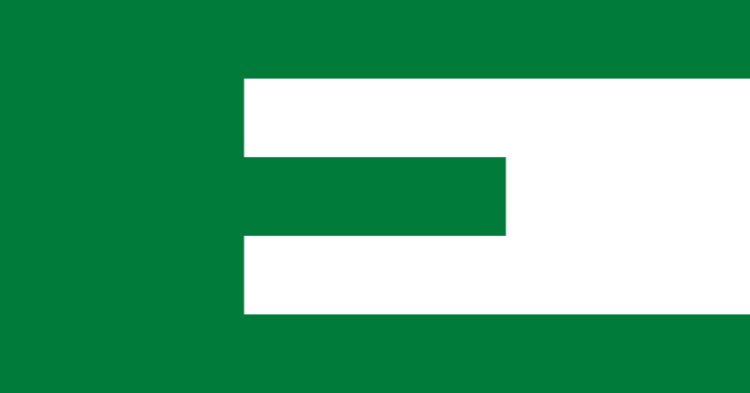The first flag of the European unity
The flag, a big red E against a white background, appeared for the first time in 1948, at the Congress in The Hague. The Congress gathered all the pro-European and federalist organizations, and led, in particular, to the creation of the European Movement, grouping together all the pro-European organizations. But on that occasion the first divisions appeared between unionists and federalists: the former being satisfied with a simple union of States, the latter aiming to create a true European Federation.
At the first European Movement’s congress in Strasbourg, in September 1948, the leaders of the new movement decided to adopt the green color instead of the red. The green E was the symbol of hope for European unity and peace, which all European peoples were longing for.
A flag for all Europeans?
However that flag was bound never to become the Union’s institutional flag. In fact, in 1986 the starred flag was chosen to represent the European Union. The flag with the green E had to remain the flag of the pro-European militants. Altered in many ways, it is still used today by many European organizations, but there is no doubt that it is the federalists who contribute most to keep it alive, together with the project it represents.
The flag of a political project
the green E is today the symbol of the political struggle in favor of the federal union of the continent
In fact, the green E stands for much more than the mere idea of European unity. It is today the symbol of the political struggle in favor of the federal union of the continent. It is not an alternative flag to the Union’s, but a complementary flag. The starred flag represents the Union as it is, that is, the European institutions and the idea of European citizenship. The green E represents the Union as it should be for the partisans of Europe and, even more so, for the partisans of a federal Europe. It is for this deeply-felt reason that we shall not let that flag disappear. That we, on the contrary, shall continue to use it and make it better known.
It represents what is not yet achieved today, but remains anyway necessary. It is the symbol of what is still to be accomplished for building the Europe we all need: a democratic and efficient Europe, a Europe capable of acting in the world and adquately coping with the challenges of the 21st century, a Europe capable of defending and promoting beyond its frontiers the values of peace, humanism and progress, which constitute the common heritage of all European citizens.

It is the flag that the federalist militants hoisted in front of the border check-points immediately after the war, that was used in the 1970s in calling for the direct election of the European Parliament, that was waved by more than 100,000 demonstrators in Milan in June 1985 to support the draft Treaty for the European Parliament (better known as the Spinelli Treaty), the same that was also displayed by tens of thousands of citizens calling for a Constitution for Europe at the Nice Summit in 2000.
It is therefore a flag signifying struggle. A flag symbolizing the Europeans’ and federalists’ fight against nationalism and the division of mankind, but also against all those who, although accepting the idea of the necessary unity of the continent, refuse to draw the self-evident consequences. It represents the European dream of unity, peace and progress. In that sense, its significance goes beyond Europe’s borders, it is universal like the project it is a symbol of.
The English version of this article was originally published in the June 2008 edition of The Federalist Debate, Papers for Federalists in Europe and the World.


1. On 22 March 2009 at 18:27, by Philipp Hessel Replying to: The Federalist Flag, the Battle-Flag for Europe
Replying to: The Federalist Flag, the Battle-Flag for Europe
There is a very interesting chronology about the process of finding a flag for Europe on the CoE homepage (see below). As far as I know the mojority of CoE member states did favour the flag of the Paneuropean Union (dating back to 1923) but it was rejected by Turkey since it contains a red cross in the middle. The design that was proposed by Arsene Heitz, which was later accepted with a reduced number of stars, was allegedly inspired by a public contest organized by the Europa-Union Hamburg in 1951. But the originally proposed 15 stars (representing the number of members at that time) were rejected by Western Germany at that time since the former autonomous region the Saarland would have represented one star and thus representing some sort of sovereinigty. So it was agreed on having 12 stars!!!
2. On 22 January 2010 at 00:09, by Tab Numlock Replying to: The Federalist Flag, the Battle-Flag for Europe
Replying to: The Federalist Flag, the Battle-Flag for Europe
I just designed a new flag for Europe and in checking the net for similar flags found this one. Pretty amazing. Mine is a bit better because it uses a more pleasant shade of green and is of a better proportion, 3:5, and is simpler.
http://www.4newamerica.com/?p=137
Direct link:
http://www.4newamerica.com/wp-content/uploads/europe_flag.gif
Follow the comments: |
|
